Men consider jeans as a wardrobe essential. But do you know what makes jeans different? Find out here.
What is Jean Selvedge? Can you provide a brief history of Jean Selvedge?
Trousers have been a popular clothing item throughout history. One type of trouser that has gained attention in the fashion world is Jean Selvedge. But what exactly is Jean Selvedge? When did it first emerge and how has it evolved over time? Fashion Bandung has the answers to these intriguing questions.
Jean Selvedge is a unique type of denim fabric that is known for its superior quality and durability. It is woven using traditional shuttle looms, resulting in a tightly woven fabric with a self-finished edge known as the selvedge. This edge prevents the fabric from fraying, making it highly sought after by denim enthusiasts.
The history of Jean Selvedge dates back to the late 19th century. During this time, textile manufacturers began using shuttle looms to produce denim fabric. These looms created a narrow width fabric, typically around 30 inches, which became known as selvedge denim.
Selvedge denim was widely used for workwear and jeans due to its durability. However, with the introduction of mass-production techniques in the mid-20th century, shuttle looms were replaced by more efficient projectile looms. This change led to the decline of selvedge denim, as the wider fabric produced by projectile looms eliminated the need for the tightly woven selvedge edge.
In recent years, there has been a revival of interest in selvedge denim, fueled by a growing appreciation for craftsmanship and heritage. Fashion brands and denim enthusiasts are now embracing the traditional methods of production and the unique characteristics of Jean Selvedge.
Today, Jean Selvedge is considered a premium material in the world of denim. Its distinctive selvage edge and high-quality construction are highly valued by those seeking authentic and long-lasting garments. From jeans to jackets, selvedge denim has become synonymous with craftsmanship and timeless style.
In conclusion, Jean Selvedge is a type of denim fabric that is woven using traditional shuttle looms, resulting in a self-finished edge called the selvedge. It emerged in the late 19th century and was widely used for workwear and jeans before being replaced by more efficient looms. However, in recent years, there has been a resurgence of interest in selvedge denim, as fashion brands and denim enthusiasts appreciate its craftsmanship and durability.
Jean Selvedge has been available in the market for a long time, but it has recently gained attention and been introduced to Vietnam. Prior to the 1950s, most types of men’s jeans were made from Selvedge fabric. The fabric was created using shuttle loom technology by ancient craftsmen.
The shuttles will pass through the warp threads of the fabric in a continuous manner to create the weft threads. They will travel all the way across the width of the fabric and then return back. As a result, the weft threads of the fabric appear seamless and uninterrupted.
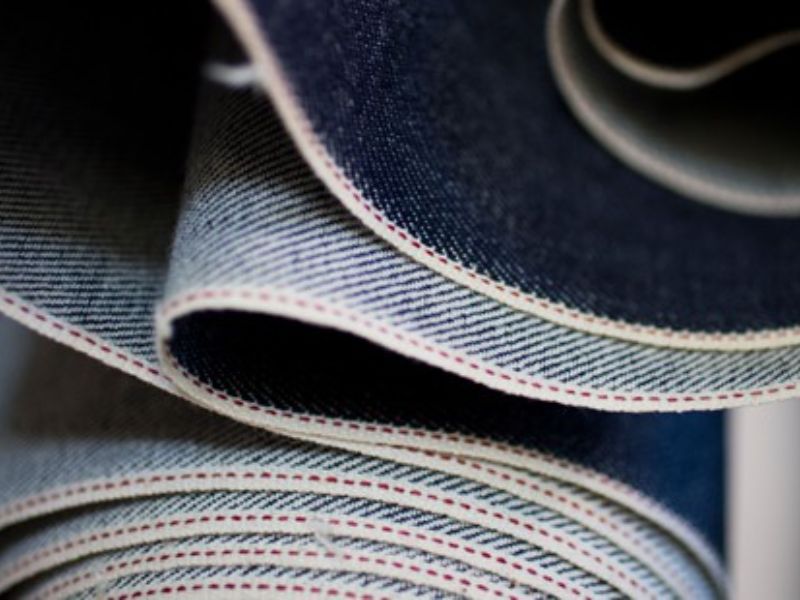
Jean Selvedge is a term used to describe a type of denim fabric that has a self-finished edge. The history of Jean Selvedge dates back to the early days of denim production. The term “selvedge” refers to the tightly woven edge on either side of the fabric that prevents it from unraveling or fraying.
The origins of Jean Selvedge can be traced back to the late 19th century when denim was first produced on shuttle looms. These looms created a narrow fabric with a clean edge, resulting in a selvage denim. This method of production was widely used until the mid-20th century, when mass production and efficiency became more important than the quality of the fabric.
However, as the demand for high-quality denim increased in recent years, the appreciation for selvage denim resurfaced. Selvage denim is known for its durability and unique characteristics. The fabric is tightly woven, making it more resistant to wear and tear compared to non-selvage denim. Additionally, selvage denim often has a distinctive colored thread running along the selvage, adding to its aesthetic appeal.
From a historical perspective, Jean Selvedge represents the craftsmanship and attention to detail that was once prevalent in the denim industry. It embodies the heritage and traditions of denim production and serves as a reminder of the quality that can be achieved through traditional manufacturing techniques.
In conclusion, the term Jean Selvedge refers to a type of denim fabric with a self-finished edge. The history of Jean Selvedge dates back to the early days of denim production, when shuttle looms created a narrow, tightly woven fabric with a clean edge. While mass production led to the decline of selvedge denim, recent years have seen a resurgence in its popularity due to its durability and unique characteristics. Jean Selvedge represents the craftsmanship and traditions of denim manufacturing and serves as a symbol of the quality that can be achieved through traditional methods.
The name “Selvedge” is derived from the feature of fabric edges being neatly finished. This particular weaving technique can only be done on narrow fabric widths with limited capacity. It is widely popular in our country and often used in various handmade products, including towels, handbags, and brocade clothing.
Selvedge fabric, also known as selvage fabric, has its origins in America and was introduced to Japan after World War II. Due to its popularity among consumers, numerous companies and garment factories in Japan have dedicated time and effort to study and produce this fabric. As a result, Japan has now emerged as a leading country for the production of high-quality selvedge fabric, earning it recognition worldwide.
After reading the previous explanation, you should now have a better understanding of Jean Selvedge. This fabric has gained popularity in recent years and has been embraced by consumers, bringing back the nostalgia and traditional values of the past. Jean Selvedge can be considered as the epitome of jeans from the “early” days.
Jean Selvedge manufacturing process.
The question “What is Jean Selvedge?” has been answered, and now we will delve into the details of the production process of this fabric with Fashion Bandung!
Selvedge is considered to be one of the top three most popular types of denim fabric in today’s market, alongside raw denim and dry denim. The production process of selvedge fabric involves the following steps:
- First, cotton is harvested, ginning and made into bales. These bales are then divided into small bags for production. All cotton is carded and then converted into small pieces, woven in a spinning machine to create yarn.
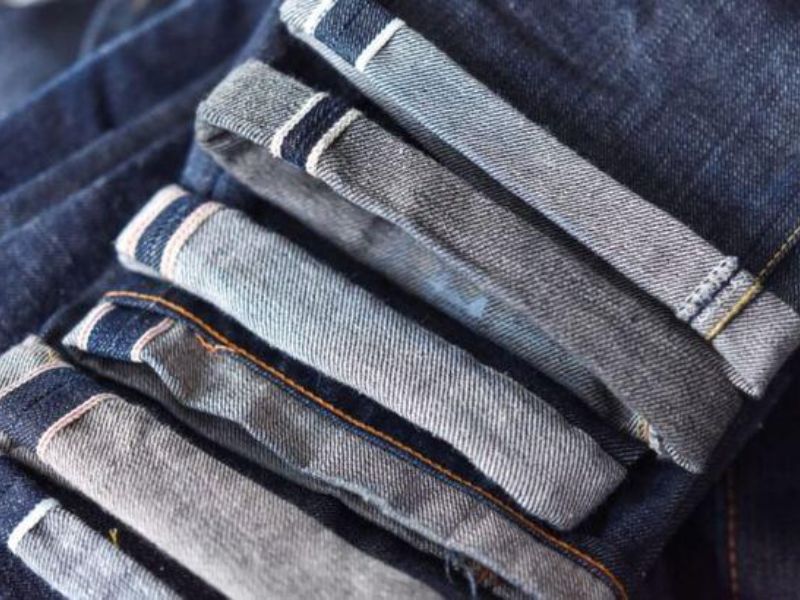
The following is a detailed explanation of the manufacturing process of Jean Selvedge:
Jean Selvedge refers to a type of high-quality denim fabric used in the production of jeans. The manufacturing process of Jean Selvedge involves several steps to ensure its durability and unique characteristics.
Firstly, the process begins with the selection of high-quality cotton fibers. These fibers are carefully chosen for their strength and ability to withstand the rigors of the manufacturing process. The cotton fibers are then cleaned and spun into yarns.
Next, the yarns are dyed using indigo dye, a natural dye that gives denim its characteristic blue color. The dyeing process involves immersing the yarns in the dye for a specific period to achieve the desired shade of blue. After dyeing, the yarns are washed to remove any excess dye and to enhance the color fastness.
Once dyed and washed, the yarns are ready for weaving. The weaving process involves interlacing the yarns on a traditional shuttle loom. This type of loom, known for its slower production speed, is used specifically for creating the selvedge edge on the fabric. The selvedge edge is a self-finished edge that prevents fraying and gives the fabric added strength and durability.
After weaving, the fabric is inspected for any flaws or inconsistencies. If necessary, minor repairs are made to ensure the fabric meets the desired quality standards. Once approved, the fabric is finished by washing and drying to achieve the desired softness and texture.
Finally, the finished Jean Selvedge fabric is sent to manufacturers who will use it to create jeans. The fabric is carefully cut and sewn, with special attention paid to incorporating the selvedge edge into the seams for added authenticity and durability.
In conclusion, the manufacturing process of Jean Selvedge involves selecting high-quality cotton fibers, dyeing and washing the yarns, weaving the fabric on a shuttle loom, inspecting and repairing any flaws, and finishing the fabric before it is used to create jeans. This meticulous process ensures that Jean Selvedge fabric is of superior quality and possesses its trademark features.
- Next, the craftsman will dye the yarn indigo to make it shiny blue, then weave the white and blue yarns into fabric. The blue yarns (warp yarns) will be woven closer together than the white yarns (weft yarns). The purpose of this is to make the woven fabric blue.
- After finishing the weaving process, people will remove loose threads and fibers to complete the product. Finally, quickly roll the fabric into rolls to be ready for export at any time.
- When sewing, people will stack the fabric pieces on top of each other to form many layers and cut them into the desired designs. After cutting and sewing, the item will be washed or stone washed as required. Thanks to that, the fabric will be softer, more convenient to use.
What are the pros and cons of Jean Selvedge?
Jean Selvedge is a type of fabric that has both advantages and disadvantages. Like other fabrics, it has its positive and negative aspects. Let’s explore them with Fashion Bandung!
Advantages:
1. Durability: Jean Selvedge is known for its strong and durable nature. It is tightly woven and can withstand wear and tear, making it suitable for long-lasting garments.
2. High-quality: Jean Selvedge is often associated with high-quality craftsmanship. It is typically made from premium quality denim, resulting in a luxurious and refined fabric.
3. Unique appearance: Jean Selvedge has a distinctive look due to its selvedge edge. This edge is created by tightly weaving the fabric on narrow looms, resulting in a neat and finished edge that adds a stylish touch to the fabric.
4. Fade pattern: Over time, Jean Selvedge fabric develops unique fade patterns. This characteristic makes each garment made from Jean Selvedge a one-of-a-kind piece, creating a sense of individuality.
Disadvantages:
1. Cost: Jean Selvedge fabric is typically more expensive compared to regular denim. The intricate weaving process and the use of high-quality materials contribute to the higher cost. This can make garments made from Jean Selvedge less accessible for those on a tight budget.
2. Stiffness: Jean Selvedge fabric is known for being initially stiff and rigid. It takes time and numerous wears to break in the fabric and achieve a comfortable fit.
3. Limited availability: Jean Selvedge fabric is not as widely available as regular denim. It is often produced by specialized mills and may have a limited range of colors and patterns to choose from.
4. Care requirements: In order to maintain the integrity of Jean Selvedge fabric, special care may be needed. This can include avoiding frequent washing and opting for gentle hand washing or dry cleaning methods, which may be inconvenient for some individuals.
By considering these advantages and disadvantages of Jean Selvedge fabric, you can make an informed decision about whether it is the right fabric choice for your fashion needs.
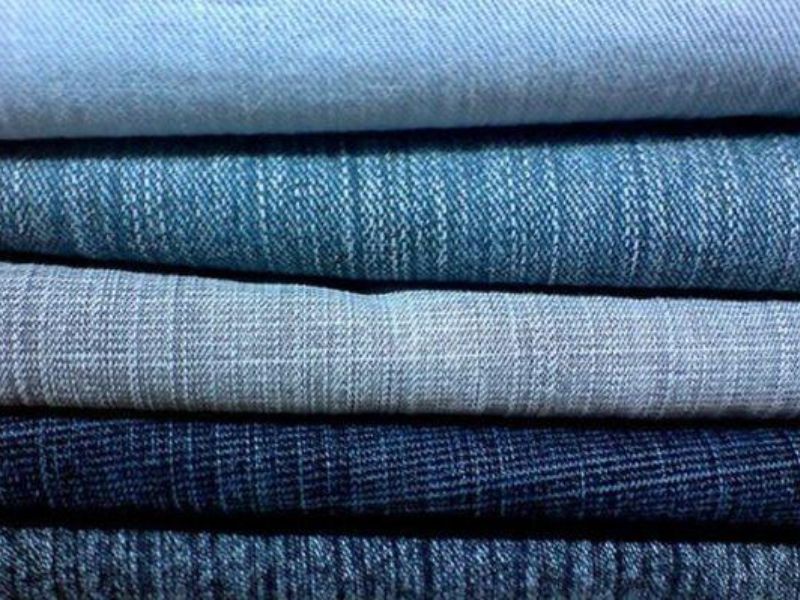
What are the advantages and disadvantages of Jean Selvedge?
Jean Selvedge is highly favored by consumers due to its exceptional strength and durability, as it is woven with high-quality Cotton fibers. Moreover, when blended with Polyester, this fabric effectively minimizes shrinkage and diminishes the visibility of wrinkles after repeated use. Currently, Selvedge finds wide-ranging applications across various industries and sectors.
- In the garment industry: Used as a sewing fabric Selvedge Jeans, men’s jacketstypes men’s shirtsshorts, overalls, skirts, sneakers,…
- In the interior field: Used to cover sofas, bean bags, lampshades,… to decorate home spaces.
- In addition, Selvedge is also used in the production of bedding and in other artistic fields.
Jean Selvedge has a few disadvantages compared to other fabrics such as cotton, spandex, and wool. One major drawback is its limited stretchability. Unlike these other fabrics, Jean Selvedge doesn’t have as much elasticity, making it unsuitable for the production of sportswear and underwear, where flexibility and stretch are essential. Additionally, Jean Selvedge takes a longer time to dry compared to other fabrics. This means that when washing and cleaning clothes made from this fabric, you will need to allocate more time for the drying process.
What sets selvedge jeans apart from regular jeans?
Many consumers often confuse Jean Thong and Jean Selvedge as they are not familiar with the differences between the two. Without proper research, it can be difficult to distinguish between the two materials. Luckily, Fashion Bandung provides information that can help consumers easily recognize and understand these two types of fabric.
Jeans are typically made from 100% cotton, which gives them excellent elasticity and provides a comfortable fit for the wearer. This makes them a popular choice among many men. Additionally, jeans are highly durable and do not require frequent washing. They also have the ability to insulate, making them suitable to wear during winter, summer, or autumn seasons.
According to experts in fashion, jeans are considered a minimalist clothing item that is suitable for both men and women. Typically, jeans are made from a type of material called Selvedge. However, it is important to note that not all pants made from Selvedge fabric can be classified as jeans.
Selvedge is a specific type of fabric that is commonly used in the manufacturing of jeans. However, it is important to note that selvedge fabric is not exclusive to jeans and is also utilized in the production of various other fashion items like bags, dresses, jackets, and more. Nevertheless, it should be understood that the term “jeans” does not solely refer to the use of selvedge fabric. Thus, it is evident that regular jeans and selvedge jeans are distinct concepts with differing characteristics.
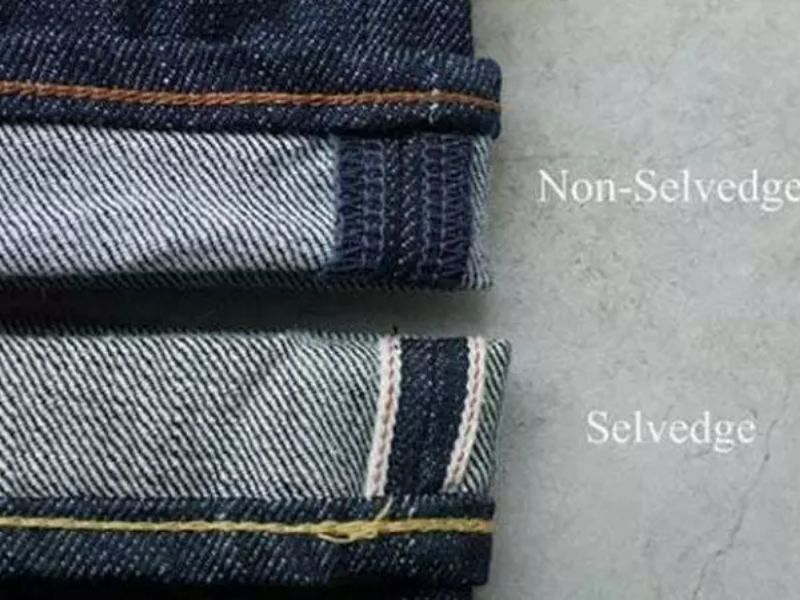
The difference between selvedge jeans and regular jeans lies in the construction and finishing details. Selvedge jeans are made using a specific type of denim, where the edges of the fabric are self-finished with a tightly woven band that prevents unravelling. This results in a clean, durable edge that is often visible on the outseam. Regular jeans, on the other hand, are typically made from denim with unfinished edges that are often overlocked or serged to prevent fraying.
Selvedge jeans are known for their high-quality craftsmanship and attention to detail. They are often produced on vintage-style shuttle looms, which create a narrower fabric width (around 30 inches) compared to the wider denim used for regular jeans (around 60 inches). The narrower fabric allows for tighter weaving, resulting in a denser, more durable fabric.
Due to the narrower fabric width, selvedge jeans require more material and have a higher production cost. They often feature superior construction techniques such as flat-felled seams, where the fabric edges are neatly folded over and stitched, providing extra strength and durability. This type of construction is rarely found in regular jeans.
Another key distinguishing feature of selvedge jeans is the visible selvedge edge on the outseam. This edge can have various colors and designs, ranging from simple plain white to intricate patterns or contrasting colors. It is considered a mark of quality and craftsmanship, and many denim enthusiasts appreciate the visual appeal of the selvedge detail.
Regular jeans, on the other hand, prioritize efficiency and mass production. They are made using wider denim fabrics, which allows for quicker manufacturing and reduced production costs. The unfinished edges are typically overlocked or serged to prevent fraying and provide a clean appearance. The construction techniques used in regular jeans are usually simpler and less time-consuming compared to selvedge jeans.
In summary, while both selvedge jeans and regular jeans serve the purpose of being denim pants, the difference lies in their construction, fabric quality, and finishing details. Selvedge jeans are a symbol of superior craftsmanship and attention to detail, featuring narrower fabric, higher construction standards, and a visible, distinctive selvedge edge. Regular jeans, on the other hand, prioritize efficiency and cost-effectiveness, featuring wider fabric, simpler construction techniques, and finished edges to prevent fraying.
Preserve the beauty of your Selvedge jeans with these instructions for long-lasting wear.
If you have an understanding of what Jean Selvedge is, it is also important to familiarize yourself with effective methods to preserve this fabric. These preservation techniques will play a significant role in prolonging the lifespan of your jeans and helping them maintain their beauty over time.
Wash properly
Men should avoid washing their Selvedge jeans too frequently. Over-washing can lead to faded and wrinkled clothing, causing them to lose their original aesthetic appeal. Additionally, it is important to follow the cleaning guidelines provided below with precision.
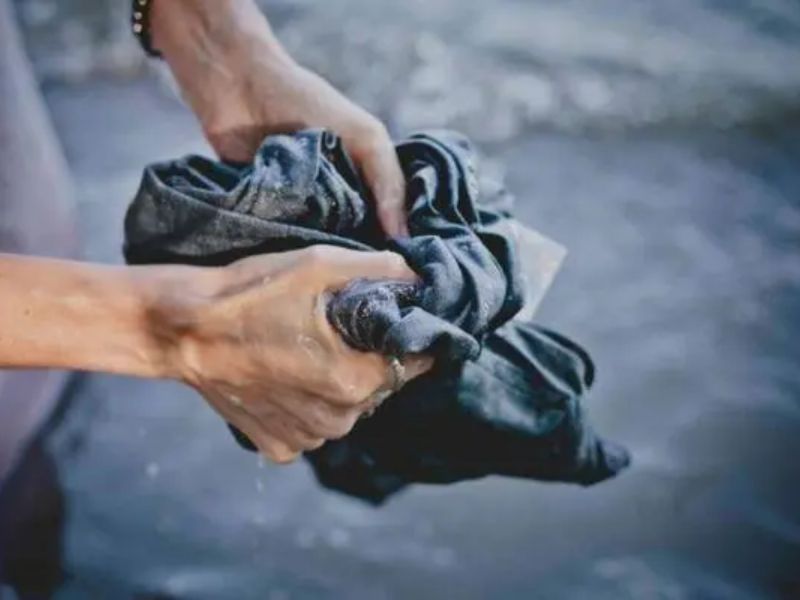
Title: Properly Washing Selvedge Jeans: A Step-by-Step Guide
Introduction:
Selvedge jeans require specific care to maintain their quality and longevity. In this guide, we will walk you through the proper steps to wash your selvedge jeans, ensuring they remain clean and well-preserved without compromising their unique characteristics.
Step 1: Read the Care Label
Begin by checking the care label on your selvedge jeans. This will provide you with valuable information on specific washing instructions recommended by the manufacturer. Pay attention to any temperature settings, hand-washing requirements, or special care suggestions.
Step 2: Pre-Treat Stains
Before placing your jeans in the washing machine, inspect them for any visible stains. If you spot any stains, gently pre-treat them with a stain remover or a solution of mild detergent and water. Allow the pre-treatment to sit for a few minutes to ensure thorough stain removal.
Step 3: Turn Jeans Inside Out
To protect the outer surface and preserve the color and design of your selvedge jeans, turn them inside out before washing. This will minimize fading and prevent excessive wear on the outside of the fabric.
Step 4: Choose a Gentle Detergent
Select a mild, color-safe detergent suitable for delicate fabrics. Avoid using harsh detergents or bleach, as they can damage the fabric and fade the color of your jeans. Consider using a detergent specifically formulated for dark or denim garments to help maintain the deep color of selvedge jeans.
Step 5: Select the Appropriate Washing Machine Cycle
When using a washing machine, choose a gentle cycle with cold water. Aggressive agitation and high heat can cause fraying, shrinkage, and damage the selvedge edge. Additionally, it’s recommended to wash your selvedge jeans with similar-colored items to prevent color bleeding.
Step 6: Use Minimal Amount of Detergent
Measure the appropriate amount of detergent according to the product’s instructions. Excessive detergent can leave residue on your jeans, affecting their appearance and texture. Stick to the recommended dosage to ensure a proper and thorough cleaning.
Step 7: Avoid Using Fabric Softener
Selvedge jeans typically have a naturally crisp and rigid feel, which is part of their appeal. Using fabric softener can soften the fabric and diminish the distinctive texture. Avoid fabric softener to maintain the authentic look and feel of your jeans.
Step 8: Air Dry
After the washing cycle is complete, carefully remove your selvedge jeans from the machine. Do not wring or twist them to prevent stretching or distortion. Instead, gently reshape the jeans and lay them flat to air dry. Avoid direct sunlight, as it can fade the denim. If necessary, you can hang them to dry, but do so away from direct heat sources to avoid potential shrinkage.
Conclusion:
By following these detailed steps, you can properly wash your selvedge jeans and ensure their longevity. Remember to always consult the care label for specific instructions and avoid any harsh chemicals or high temperatures that could compromise the quality and appearance of your beloved selvedge jeans.
To maintain the quality of Selvedge fabric, it is advisable to opt for liquid detergent instead of washing powder. The surface of Selvedge fabric tends to be sticky, making it challenging for washing powder to dissolve completely. If washing powder is used, it may leave behind residue and potentially result in color fading, compromising the overall quality of the fabric. Therefore, liquid detergent is a better choice for ensuring effective and safe cleaning.
In order to maintain the quality of selvedge jeans and prevent color transfer, it is recommended to wash them separately from other garments. Selvedge fabric has a tendency to fade during the initial few washes, and as a result, there is a risk of the color bleeding onto other items such as shirts, towels, socks, and so on. Therefore, it is important to follow this rule diligently to avoid any undesirable patchy blue stains on your other clothing items.
To properly care for his Jean Selvedge pants, he should consider hand washing them in warm water. The recommended soaking time should not exceed 45 minutes. Alternatively, if he chooses to use a washing machine, it is advisable to turn the pants inside out, button them, and select the slowest spin cycle available. This method helps minimize friction, preserves the garment’s shape, and reduces the likelihood of fading.
To effectively maintain your Selvedge Jeans, it is crucial to adhere to the manufacturer’s instructions and recommendations provided on the label. This includes paying close attention to the recommended temperature and washing method. By following these guidelines, you can ensure the longevity and quality of your Selvedge Jeans.
Drying and ironing
After you have finished cleaning your Selvedge jeans, it is important to properly dry them to maintain their quality. It is recommended to dry them in a cool and dry location, while avoiding direct exposure to sunlight. Allowing the jeans to dry naturally is preferable, as excessive use of a dryer can result in the fabric fading easily. Moreover, the high temperature of the dryer can cause the fabric fibers to shrink, which can lead to wrinkles and a loss of aesthetic appeal.
On days when it is rainy or humid, ironing your pants can help them dry more quickly. Using a steam iron is recommended as it can also help prolong the lifespan of your pants.
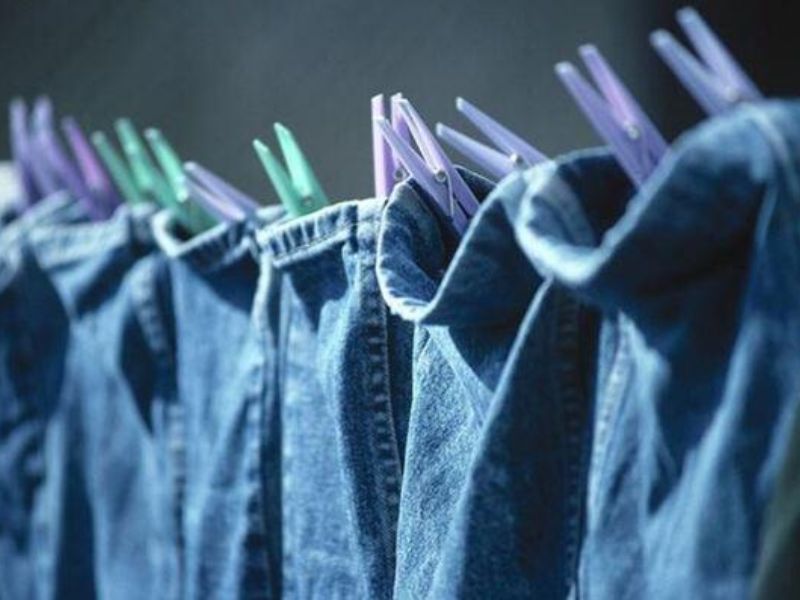
Ironing Jean Selvedge:
I am going to provide more information regarding the process of ironing jean selvedge.
Selvedge refers to the self-edge of the denim fabric. It is the tightly woven part of the denim that runs along the edges of the fabric. The purpose of selvedge is to prevent fraying and ensure durability. Selvedge jeans are often considered premium quality and tend to have a higher price point compared to regular jeans.
When it comes to ironing jean selvedge, it is important to take certain precautions to avoid damaging the fabric. Here are some guidelines to follow:
1. Start by reading the care label on your jeans. Different denim brands may have specific instructions for ironing. It is always best to follow the manufacturer’s recommendations.
2. Set your iron to the appropriate temperature. Most selvedge jeans are made of raw or dry denim, which can be more sensitive to heat than pre-washed denim. As a general rule, use a medium-low heat setting to prevent scorching or shrinking the fabric.
3. Before ironing, ensure that your jeans are clean and free from any stains. Ironing over stains can set them into the fabric, making them more difficult to remove later.
4. To prevent unwanted creases or marks, turn your jeans inside out before ironing. This will also help preserve the color and appearance of the selvedge line.
5. Place a thin cotton cloth or a pressing cloth over the selvedge area before ironing. This additional layer of fabric will act as a barrier between the iron and the denim, minimizing any direct heat exposure to the selvedge edge.
6. Gently press the iron over the cloth-covered selvedge area, applying light pressure. Avoid dragging or making repetitive movements with the iron, as this can distort the fabric or create shiny spots.
7. If your jeans have any sharp creases or wrinkles, consider using a steam iron or a clothes steamer to remove them. The steam will help relax the fabric without the need for heavy pressure or direct heat.
8. Once you have finished ironing, allow your jeans to cool down before wearing or folding them. This will help the fabric retain its shape and prevent new wrinkles from forming.
Remember, selvedge jeans are unique and require extra care when ironing. By following these guidelines, you can maintain the quality and appearance of your jeans while ensuring they look their best.
Arrange and store
Typically, men tend to fold their Selvedge jeans and store them in their closets. While this approach may seem acceptable, it is not the most optimal solution due to the jeans’ thick fabric. Consequently, over time, folding the jeans in this manner will result in wrinkles, requiring additional time and effort to iron them before their next use.
To properly arrange and preserve selvedge jeans, the most recommended method is to loop the belt loop of the jeans through the neck of a hanger and hang them in a closet. Alternatively, you can consider investing in specially designed S-shaped hangers specifically meant for jeans. These hangers help maintain the shape of the jeans and minimize the appearance of wrinkles. By utilizing these techniques, you can ensure that your selvedge jeans remain in excellent condition for a longer period of time.
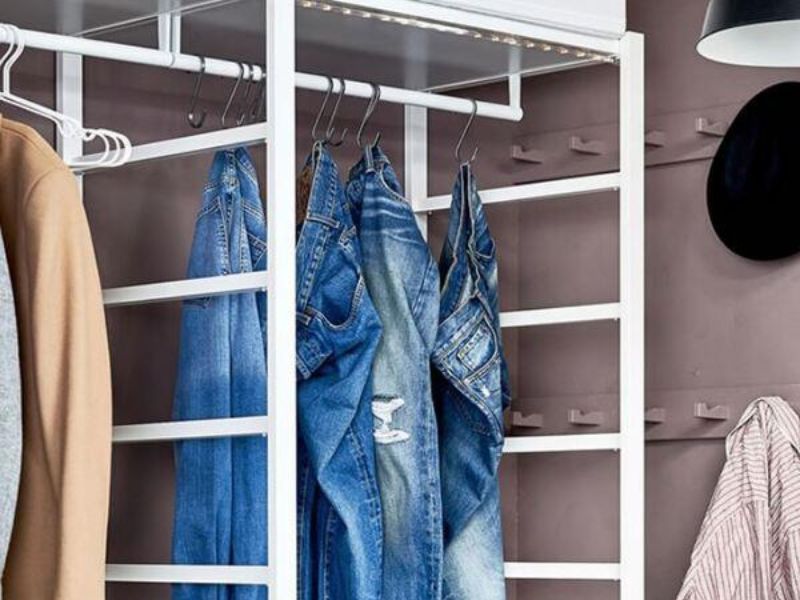
Jean Selvedge Clothing Arrangement and Care involves organizing and maintaining garments made from selvedge denim fabric. Selvedge denim is a specific type of denim that has a finished edge on both sides of the fabric, which prevents fraying and creates a clean and durable finish.
To properly arrange and care for selvedge jeans and other clothing items made from selvedge denim, it is important to follow specific guidelines. These guidelines may include storing the garments properly to prevent creasing and damage, washing them with care to maintain color and shape, and avoiding excessive wear to preserve their quality.
Proper arrangement of selvedge clothing involves folding or hanging the garments in a way that minimizes creasing and ensures longevity. Folding selvedge jeans along the original creases and storing them flat or in a drawer can help prevent unnecessary wrinkles. Hanging the jeans on sturdy hangers with clips can also be an effective way to maintain their shape and prevent creasing.
In terms of care, selvedge jeans should be washed sparingly to preserve their color and fit. It is recommended to follow the instructions on the garment’s care label or consult the manufacturer’s guidelines. Typically, washing them inside-out in cold water on a gentle cycle and using mild detergent is preferred. It is important to avoid bleach and harsh chemicals, as they can deteriorate the fabric and cause discoloration.
Excessive wear and tear should be avoided to prolong the life of selvedge clothing. Washing them less frequently, spot cleaning small stains, and using a fabric brush or lint roller for maintenance are recommended to avoid unnecessary stress on the fabric. Additionally, it is important to avoid exposing selvedge denim to direct sunlight for long periods, as it can fade the color.
By following these guidelines for arrangement and care, selvedge clothing can be preserved and enjoyed for a long time, maintaining its high-quality appearance and durability.
What factors to consider when selecting Selvedge Jeans?
There are numerous types of selvedge jeans available in the market nowadays. Each design caters to the unique needs and preferences of individuals, making them suitable for all body shapes. If you are wondering how to select the perfect pair of selvedge jeans for yourself, Fashion Bandung has provided some valuable suggestions that you should consider.

Title: A Comprehensive Guide on Selecting the Perfect Pair of Selvedge Jeans
Introduction:
In this article, we will delve into the intricate world of selvedge jeans and provide you with everything you need to know to make an informed decision when selecting the right pair. From understanding the key features and benefits of selvedge denim to exploring different styles and fits, this guide will equip you with the knowledge necessary to choose the perfect selvedge jeans.
Understanding Selvedge Jeans:
Selvedge jeans are crafted using traditional weaving techniques that create a self-finished edge on the fabric, preventing it from unraveling. This edge, which is often identified by a unique colored line, adds a touch of authenticity and character to the jeans. Furthermore, selvedge denim is typically woven on old-school shuttle looms, resulting in a sturdy, densely woven fabric known for its durability and longevity.
Key Factors to Consider:
1. Quality: Selvedge jeans are renowned for their superior quality. It is important to examine the fabric’s weight, weave pattern, and overall craftsmanship when evaluating the durability and longevity of potential options.
2. Fit: Consider your body type and personal style preferences when selecting the fit of your selvedge jeans. Whether you prefer a slim, straight, or relaxed fit, ensure that the jeans flatter your physique and provide the desired level of comfort.
3. Style: Selvedge jeans come in various styles, including raw, distressed, and pre-washed. Raw selvedge jeans are left untreated, allowing for personalized fading and distressing over time. Distressed jeans offer a worn-in look, while pre-washed selvedge jeans provide a softer feel and require less breaking in.
4. Selvedge Line: Pay attention to the selvedge line, which runs along the outseam of the jeans. This line adds a distinctive detail and can vary in color and design, allowing you to select a pair that aligns with your aesthetic preferences.
5. Brand Reputation: Research and consider reputable brands known for their commitment to quality production. Established selvedge denim manufacturers often utilize premium materials and employ skilled artisans, guaranteeing a superior product.
6. Price: Selvedge jeans can vary significantly in price. While premium options can be expensive, they often offer unparalleled quality and craftsmanship. Evaluate your budget and prioritize accordingly.
Conclusion:
Choosing the right pair of selvedge jeans involves understanding the intricacies of this unique type of denim. By considering factors such as quality, fit, style, selvedge line, brand reputation, and price, you can make an informed decision that ensures you find the perfect pair that not only fits well but also reflects your personal style and lasts for years to come.
To enhance their appearance and style, it is important for men to select pants that are well-suited to their body shape, weight, and height. Opting for pants that fit these criteria will not only make men look more attractive and fashionable but will also accentuate their body’s strengths while concealing any perceived weaknesses. A carefully chosen pair of pants can truly enhance a man’s overall aesthetic and boost his confidence.
Afterwards, take your time to select a pair of Selvedge jeans that aligns with your budget. It is important to exercise caution and avoid being swayed by attractive low prices that may indicate subpar quality. Purchasing low-quality jeans that quickly fray, fade, or deteriorate after only a few wears should be avoided.
Fashion Bandung is a renowned brand specializing in men’s fashion, offering a wide range of exquisitely designed, top-notch jeans at affordable prices. To explore our impressive collection, you have the option to visit our physical store directly or conveniently browse through our products on Fashion Bandung’s e-commerce platforms.
In the above article, Fashion Bandung has provided comprehensive answers to your questions about Jean Selvedge and how it differs from regular jeans. Additionally, the article contains valuable information about the production process of Jean Selvedge, tips on how to preserve them, and advice on selecting the right jeans for men. By reading this article, you will gain a deeper understanding of fashion and be better equipped to make informed decisions when choosing jeans for yourself.
Fashion Bandung is a clothing brand that specializes in men’s fashion. With a wide range of stylish and trendy clothing options, Fashion Bandung offers men the opportunity to express their personal style and stay in line with the latest fashion trends. From casual wear to formal attire, Fashion Bandung caters to every fashion need of men. Whether it’s a sophisticated suit for a formal event or a comfortable and fashionable outfit for a casual day out, Fashion Bandung has got it all. With a focus on quality and style, Fashion Bandung strives to provide men with the perfect clothing options to enhance their overall look.

